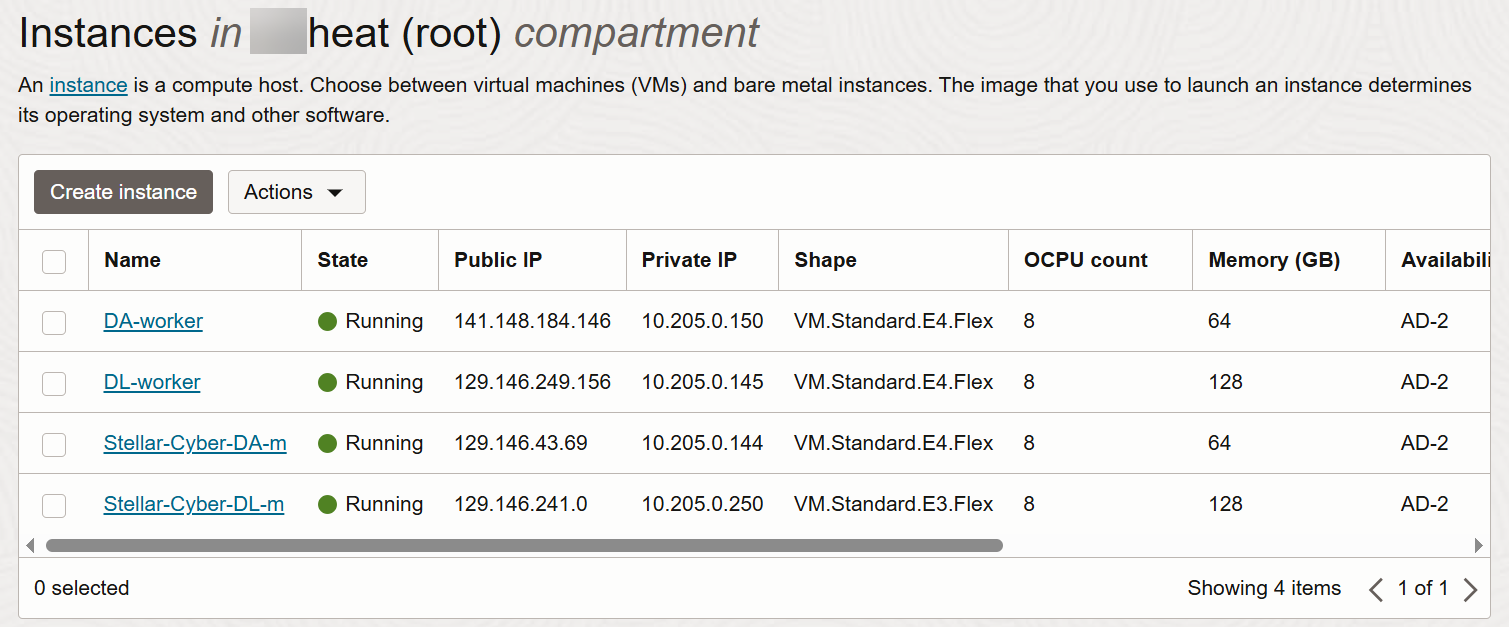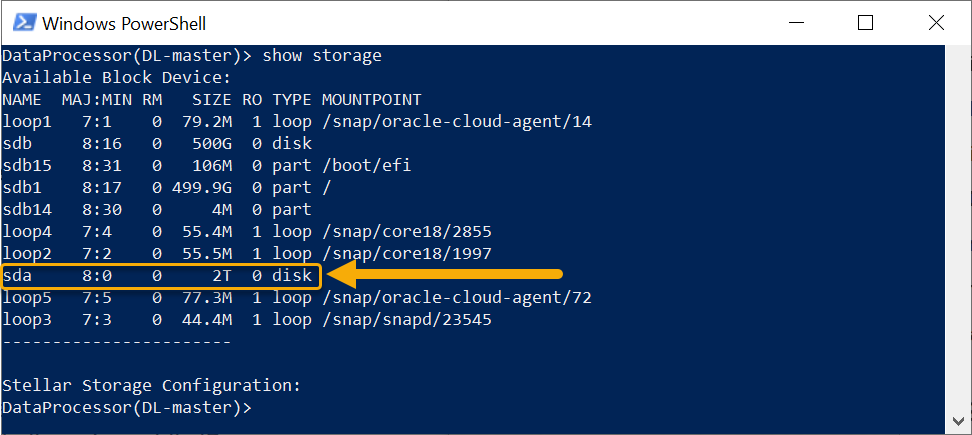Configuring Worker Nodes in the CLI
Once you have launched instances for the DL and DA worker nodes, you are ready to configure them in the CLI:
Get IP Addresses for Instances
When the instances for your deployment are up and running, you are ready to log in to their consoles and assign roles.
First, however, you need the IP addresses that OCI assigned when you launched your instances:
- Log in to your OCI Console.
-
Navigate to Compute | Instances. The active instances appear.
- Copy the Public IP and Private IP for the DL-master, DL-worker, and DA-worker instances.
Configure the DL-worker Node in the CLI
Use the following procedure to configure the DL-Worker node in its CLI:
-
Access the console of the DL-worker instance using an SSH connection to the public IP address you copied in the previous procedure. For example, from Windows PowerShell:
PS > ssh -i <ssh-key> aella@<public ip address> - Log in. The default username/password is aella/changeme. You are immediately prompted to change the password.
-
Access the console of the DL-worker instance using the private IP address you copied in the previous procedure.
-
Log in. The default user/password is aella/changeme. You are immediately prompted to change the password.
-
Change the password.
The system closes your connection automatically.
- Reconnect to the DL-m instance using the new password you just set.
- The prompt changes to DataProcessor>.
-
Enter the following command:
show hostname -
The hostname is set to the name you configured for the instance. You can change it using the set hostname <hostname> command, if you want. For example:
DataProcessor> set hostname DL-workerIf you do change the hostname, you must reboot the virtual machine to apply the change.
-
Set the role of the instance to resource as follows:
DataProcessor> set role resourceThe prompt changes to
DataProcessor(resource)>to indicate the role change.Make sure you set the role to resource! You'll change the role for this resource in the Stellar Cyber user interface in Configure the DL-worker Node in the CLI
-
OCI automatically configures DNS and NTP settings for the instance. You can verify the settings with the show dns and show ntp commands, respectively.
-
Configure the DL-worker instance to use the block volume you attached in OCI as follows:
-
Use the set cm <ip_address> command to set the IP address of the Data Lake master's management interface as follows:
-
Retrieve the private IP address of the DL-Master using the Instances list in the OCI Console.
-
Enter the following command using the IP address you just retrieved:
DataProcessor> set cm <private_ip_address of DL-m>
-
-
Use the reset command to apply your changes. This command starts all Stellar Cyber microservices using your new settings.
-
Confirm the reset. The image is downloaded (which can take a while, depending on your network) and installed.
-
Verify that everything is installed, ready, and running with the
show rolecommand. When the system reportsresource, the installation of the DL-worker instance is complete. Next, we need to convert it from its current resource role to a DL-Worker from within the Stellar Cyber user interface. Refer to Adding Worker Nodes in the Stellar Cyber User Interface.
Configure the DA-Worker Node in the CLI
Use the following procedure to configure the DA-worker node in the CLI:
-
Access the console of the DL-m instance using an SSH connection to the public IP address you copied in Get IP Addresses for Instances.. For example, from Windows PowerShell:
PS > ssh -i <ssh-key> aella@<public ip address> - Log in. The default username/password is aella/changeme. You are immediately prompted to change the password.
-
Change the password.
The system closes your connection automatically.
- Reconnect to the DL-m instance using the new password you just set.
- The prompt changes to DataProcessor>.
-
Enter the following command:
show hostname -
The hostname is set to the name you configured for the instance. You can change it using the set hostname <hostname> command, if you want. For example:
DataProcessor> set hostname DA-workerIf you do change the hostname, you must reboot the virtual machine to apply the change.
-
Set the role of the instance to resource as follows:
DataProcessor> set role resourceThe prompt changes to
DataProcessor(resource)>to indicate the role change.Make sure you set the role to resource! You'll change the role for this resource in the Stellar Cyber user interface in Configure the DL-worker Node in the CLI
-
OCI automatically configures DNS and NTP settings for the instance. You can verify the settings with the show dns and show ntp commands, respectively.
-
Use the set cm <ip_address> command to set the IP address of the Data Lake master's management interface as follows:
-
Refer to the private IP address of the DL-m you copied in Get IP Addresses for Instances.
-
Enter the following command using the IP address you just retrieved:
DataProcessor> set cm <private_ip_address of DL-m>
-
-
Use the reset command to apply your changes. This command starts all Stellar Cyber microservices using your new settings.
-
Confirm the reset with an uppercase YES. The image is downloaded (which can take a while, depending on your network) and installed.
-
Verify that everything is installed, ready, and running with the
show rolecommand. When the system reportsresource, the installation of the DA-worker instance is complete. Next, we need to convert it from its current resource role to a DA-worker from within the Stellar Cyber user interface.
Refer to Adding Worker Nodes in the Stellar Cyber User Interface





